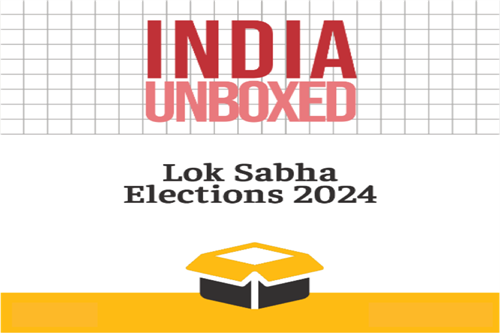
The NDA/BJP appeared to have had a slight edge. BJP with their alliances could win in around 300 seats. But, the changing political and social landscape of India could reduce NDA below 250; and BJP below 200.
Sumaiya Noorani, Samriddhi Lakhar
Over a billion people of India, living inside and outside, rural and urban, Hindu, Muslim,
Christian, Parsi, and others, are waiting for the results of the 2024 Lok Sabha elections.
Many factors will play crucial roles in this election outcome: from the aspirations of 18.5
million first-time voters aged 18-19 with a substantial portion of the electorate under
30, to diminishing Modi factor, to disillusionment of the people on employment and
ache din front. Young voters were instrumental in the Bharatiya Janata Party’s (BJP)
victories in 2014 and 2019. Campaigns and manifestos are increasingly tailored to
address the concerns and aspirations of this dynamic group; this will continue to be in
the BJP way. But the INDIA bloc and other regional parties opposing the BJP/NDA bloc
have managed to gain a lot of ground in penetrating and reaching to the masses and
talking to them about the dangers of an extreme right winged government backed by
corporate giants. The concerned civil society has majorly moved away from the
BJP/NDA side. Civil society in India hugely value the ideals of secularism, democracy,
and the constitution. With democracy and secularism in danger, political parties
advocating policies, opportunities and benefits to favour a religious majority and
conveniently excluding certain communities, blatant hate speech and then blatant
denial of it, reinforcement of the Citizenship Amendment Act (CAA), etc. have further
damaged the image of the ruling establishment, and the trust common people had on
them.
The Lok Sabha Election of 2024 in India showcased several noteworthy trends that
would shape the political outcome of the elections:
Digital Campaigning Dominance: The influence of digital campaigning continued to
rise, with political parties leveraging social media platforms, targeted advertising, and
data analytics to reach voters.
Regional Parties' Resurgence:
Regional parties play a pivotal role in several states,
emphasizing regional issues and forming strategic alliances with national parties. These
parties capitalize on their strong grassroots networks and deep understanding of local
dynamics to secure significant electoral gains.
Focus on Development:
putting aside religion and ideologies, the electorate exhibit a
continued emphasis on development-oriented agendas, including infrastructure,
employment generation, healthcare, and education. Parties that present credible and
innovative development plans garner significant support from voters, especially in rural
and semi-urban areas.
Identity Politics and Social Issues:
Identity-based politics remain a significant factor,
with parties appealing to caste, religious, and linguistic identities to mobilize support.
Additionally, social issues such as gender equality, environmental conservation, and
minority rights gain prominence, influencing voter preferences and candidate selection.
Evolving Coalition Dynamics:
Coalition politics remain integral to the Indian electoral
landscape, with pre-poll and post-poll alliances determining government formation. The
fluidity of coalition dynamics underscore the importance of strategic partnerships and
consensus-building in a diverse and multi-party democracy like India.
Corruption:
Disclosure of major scams like, Electoral bonds, will definitely have an
effect on the way informed voters cast their vote.
Technological Innovations in Voting:
The adoption of technological innovations to
streamline the voting process, including electronic voting machines (EVMs), and online
registration facilities, which are aimed to enhance transparency, efficiency, and
accessibility in the electoral process, may make it easy for the powerful to misuse it and
manipulate it to their advantage.
An analysis of seven states that come among the 10 biggest states (having the most
number of constituencies) indicate a decline of the unquestioned continuity of reign of
the BJP/NDA bloc. With the over-dependency on temple politics and hindutva ideology,
people have lost faith in them and have stopped believing that they would bring about
progress and employment in the modern sense of the term. Their outward image as a
party with less corruption is broken with the surfacing of electoral bonds scam. NDA has
poorly managed the Manipur unrest, farmer’s protest, and attacks on minorities and
institutions. After the initial phases of voting the BJP side look doubtful of their own
victory, and are going desperate.
What has worked positively for the congress-led INDIA bloc is that they have stood
together as an opposition force, though some have moved away and are contesting
independently; programmes like Bharat Jodo Yatras by Rahul Gandhi have projected
congress as a party that knows the needs and aspirations of the common folks, and
Rahul has emerged as a competent leader; congress has won elections in recent major
state elections, like, Karnataka and Telangana; and congress’ and its allies’ image as a
side that upholds the constitution and its democratic and secular values.
On 4 June when the Lok Sabha election boxes (EVMs) are unboxed, who will have the
last laugh? If the above discussed seven states, having 303 seats of 543, are of any
indication, the NDA/BJP have a slight edge. BJP with their alliances could win in around
300 seats.
But there are other extraneous factors, like the small states and minorities with big
problems of exclusion, less attention given to them, and being at the verge of losing their
identity and position often because of the generic BJP stance, ‘one nation, one vote, one
language, one religion, etc.” BJP has failed to deliver in many important fronts like,
employment, price fluctuation, and human rights. The clean image of BJP is broken with
the electoral bonds’ scam. The Modi wave factor is diminishing. Many regional small
parties have resurged and taken their position against BJP.
And, after 10 years of BJP
rule, with the anti-incumbency factor, many look forward to a change. Yes. The changing
political and social landscape of India could reduce NDA below 250; and BJP below 200.
The country awaits the greatest election results on the planet -a result that is capable of
changing the nature and destiny of a nation of over 1.2 billion people.